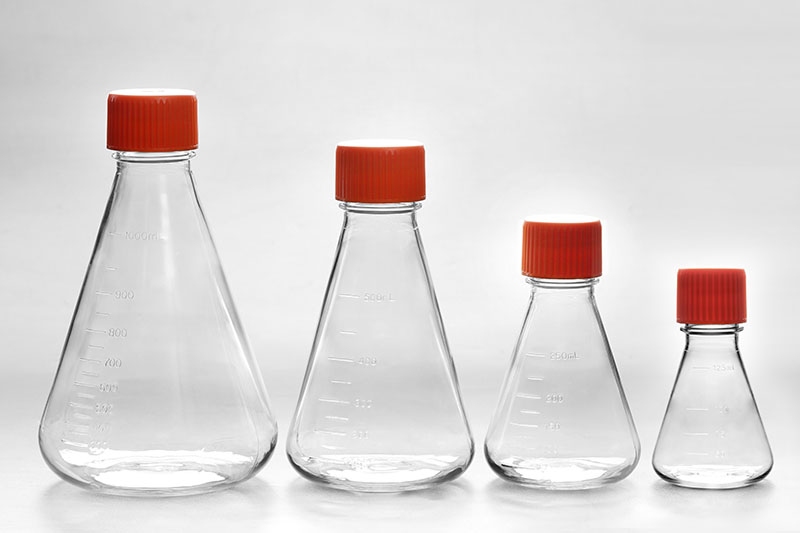ขวดเขย่า erlenmeyer เป็นวัสดุสิ้นเปลืองเซลล์ที่ใช้กันทั่วไปในกระบวนการเพาะเลี้ยงเซลล์ เหมาะอย่างยิ่งสำหรับการเพาะเลี้ยงเซลล์แบบแขวนลอยแบบเต็มเวลา การเตรียมปานกลางหรือการเก็บรักษา และสามารถใช้กับเครื่องปั่นที่มีความจุสูง
การเพาะเลี้ยงเซลล์ต้องการข้อกำหนดด้านสิ่งแวดล้อมที่สูง เช่น การฆ่าเชื้อ อุณหภูมิที่เหมาะสม pH และบางอย่าง ภาวะโภชนาการ ต้องบรรลุเงื่อนไขเหล่านี้ด้วยความช่วยเหลือของ erlenmeyer shake flasks ดังนั้น erlenmeyer ขวดเขย่า มีข้อกำหนดที่เข้มงวดตั้งแต่วัสดุจนถึงกระบวนการผลิต erlenmeyer ขวดเขย่า โดยทั่วไปจะใช้วัสดุ PC ปลอดสารบิสฟีนอล A และวัสดุ PETG และการประมวลผลใช้กระบวนการฉีดยืดแบบฉีดขั้นตอนเดียว ซึ่งเรียกอีกอย่างว่ากระบวนการผลิตแบบฉีดยืดแบบขั้นตอนเดียว . หลักการทำงานของมันคือการฉีดแม่พิมพ์เปล่าโดยใช้เครื่องฉีดขึ้นรูป ยืด parison ร้อนตามยาว แล้วส่งผ่านอากาศอัดเพื่อยืดออกด้านข้างเพื่อให้ได้ผลิตภัณฑ์ที่มีรูปร่างเหมือนกับโพรงแม่พิมพ์
การฉีด กระบวนการยืดและการขึ้นรูปแบบเป่าของวิธีการประมวลผลนี้เสร็จสมบูรณ์ตามลำดับในอุปกรณ์เดียว สามารถขึ้นรูปด้วยความเร็วสูงได้โดยไม่ต้องให้ความร้อนกับพรีฟอร์มซ้ำ ชิ้นส่วนกระบวนการที่ซับซ้อนที่สุดจะถูกละทิ้ง และใช้โครงสร้างกระบวนการที่เหมาะสมที่สุด ตระหนักถึงการผลิตที่มีเสถียรภาพของผลิตภัณฑ์โดยตรง ปรับปรุงอัตราของผลิตภัณฑ์ที่ผ่านการรับรอง และเทคโนโลยีประหยัดพลังงาน
The erlenmeyer shake flasks ผลิตโดยกระบวนการผลิตแบบยืด-เป่ามีปากที่กลมและเรียบเนียนยิ่งขึ้น การสัมผัสและความรัดกุมของฝาขวด และการต้านทานแรงกดที่มากขึ้น ซึ่งเป็นการวางรากฐานสำหรับความก้าวหน้าของการเพาะเลี้ยงเซลล์ที่ราบรื่น
The FAI climbed 5.9 percent year-on-year in the first 11 months of 2018, quickening from the 5.7-percent growth in Jan-Oct, the National Bureau of Statistics (NBS) said Friday in an online statement.
The key indicator of investment, dubbed a major growth driver, hit the bottom in August and has since started to rebound steadily.
In the face of emerging economic challenges home and abroad, China has stepped up efforts to stabilize investment, in particular rolling out measures to motivate private investors and channel funds into infrastructure.
Friday's data showed private investment, accounting for more than 60 percent of the total FAI, expanded by a brisk 8.7 percent.
NBS spokesperson Mao Shengyong said funds into weak economic links registered rapid increases as investment in environmental protection and agriculture jumped 42 percent and 12.5 percent respectively, much faster than the average.
In breakdown, investment in high-tech and equipment manufacturing remained vigorous with 16.1-percent and 11.6-percent increases respectively in the first 11 months. Infrastructure investment gained 3.7 percent, staying flat. Investment in property development rose 9.7 percent, also unchanged.
 English
English



















































